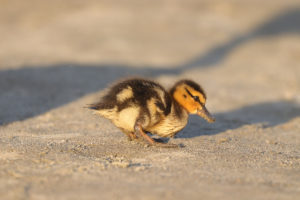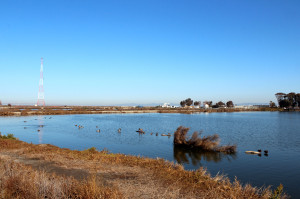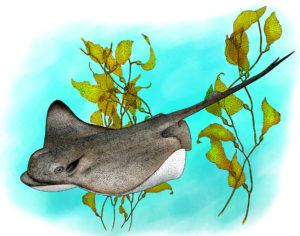The great rafts of ducks on San Francisco and Tomales bays, mostly surf scoter, greater and lesser scaup, and canvasback, are a wintertime spectacle. Scoter flocks can range from many hundreds to a few thousand birds. Why do they form these aggregations?
In summer most of these bay ducks nest at isolated sites in the prairie pothole country of the upper Midwest or the boreal forest of Alaska and Canada. In fall, they migrate to coastal waters or large interior lakes, where the rafting occurs. (“Raft” comes from a Middle English noun meaning a whole lot of something, as in “a raft of trouble.”)
According to U.S. Geological Survey biologist Susan De La Cruz, rafting among San Francisco Bay diving ducks is primarily about food. The rafts form where the prey is–mainly bivalves like clams and mussels. The small, short-necked lesser scaup lately targets the introduced overbite clam, which it picks off the Bay floor. Longer-necked canvasbacks go for the deeper-digging macoma clams.
Diving ducks eat so many clams that they may even influence the entire estuarine food web. Along with clam-eating fish, surf scoters consume enough overbite clams in San Pablo Bay to reduce the filter-feeding bivalve’s negative impact on phytoplankton populations. By January overbite clam numbers have fallen and the scoters move to central San Francisco Bay, where they likely feed on nonnative Manila clams.
Surf scoters are fond of herring roe, and they join feeding frenzies around spawning events. Some scoters’ spring migration coincides with the “silver wave” of herring spawning from Puget Sound to southeastern Alaska.
Food is not the only factor that dictates winter rafting locations. “The birds may be trying to find a quiet area,” says De La Cruz. “There are definitely some areas they use for sleeping and resting.” There’s no structure to the winter flocks, and individual ducks may shift from one grouping to another.
There’s also an element of safety in numbers. In 1971, evolutionary biologist William D. Hamilton published an article titled “Geometry for the Selfish Herd,” which gave mathematical support for flocking or herding as an anti-predator defense. The idea is that a bird toward the center of a flock is less likely to be picked off by a cruising raptor. Some duck species bunch together when a predator flies overhead. Predation may no longer be much of a risk in San Francisco Bay; up the coast, where bald eagles are common, it’s a different story.
The downside of rafting is that more ducks may be vulnerable to catastrophes. Surf scoters and greater scaup suffered significant losses during the 2007 Cosco Busan oil spill. Scoter numbers were down during the next two winters.
The general decline of scoter and scaup populations over the past 50 years has biologists scrambling for answers. The trend may be driven by changes in wintering areas like San Francisco Bay, migration stopover sites, or far-northern breeding grounds. Surf scoters, which have low reproductive rates, are a particular concern. Conditions in the winter range, including the replacement of native bivalve species by exotics, may mean that the birds head north in poorer condition. Diminishing herring runs along the way may be another factor.
Researchers have been using satellite-tracked radiotelemetry to put all those pieces together. They hope to learn whether breeding success is linked to the winter clam and herring roe supply.
It’s also possible that climate change is involved, although so far there’s little supporting field data. The ducks’ spring prey–insects and other freshwater invertebrates–may be emerging before the birds arrive at their boreal forest nest sites. If the ducks don’t reset their migration clocks, food won’t be available when ducklings hatch.
Without its ducks, San Francisco Bay would be a poorer place. In the 1920s, naturalist William Leon Dawson described the noise of scoters’ wings as “a murmuring sound, which is not unpleasant to the ear. Indeed, a teeming bay, a-hum with the music of a thousand flying Scoters, is an orchestra in itself and needs no help of wind or wave to write its score upon the heart.”

.jpg)




